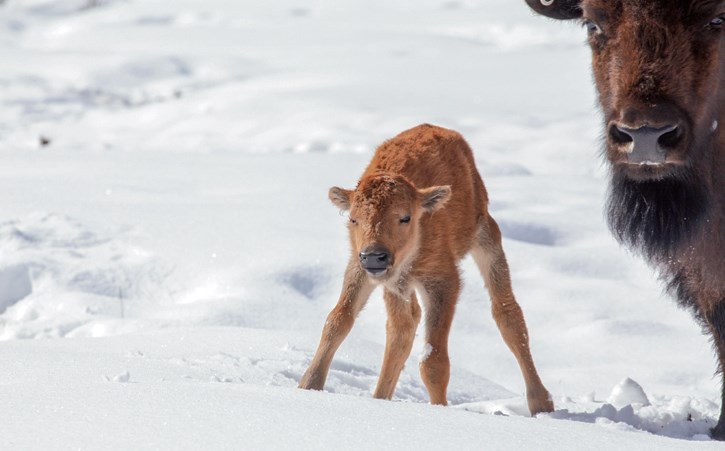Baby bison have been born into the wilds of Banff National Park for the first time in 140 years.
The first calf was born in the Panther River Valley on Saturday (April 22) within the 18-hectare fenced pasture. As of press time, two more calves joined the 16-member bison herd that was reintroduced back into the park in February.
Bill Hunt, Parks Canada’s head of resource conservation for Banff National Park, said the birth of the first calves is an important milestone in the $6.6 million bison reintroduction project.
“We’re very, very happy that we’ve had our first baby bison born in the backcountry of Banff in over 140 years,” he said.
“They all look healthy and are nursing well and moving around well.”
Ten pregnant two-year-old females and six two-year-old bulls were moved from Elk Island National Park in February to an 18-hectare fenced pasture in the middle of a 12,000 square kilometre reintroduction zone that falls within historic bison range.
Cows and calves stay together for the first while, and staff on site are watching herd dynamics to make sure cows and calves aren’t feeling over-crowded in the 18 ha pasture with the six bulls.
“We could have up to 10 possible calves, so there’s potential for seven more,” said Hunt, noting there have been no complications with any of the births so far. “There have been no issues to date.”
The bison herd is being held within this fenced pasture for 16 months, where they are given water and supplementary food, such as hay.
Cows and bulls will mate again in August. The bison will remain in fenced pasture there until they have calved twice. By the time they are released into the larger reintroduction zone in June 2018, it’s hoped there will be about 30 animals.
The idea behind the soft-release pasture, and having bison calve their twice, is to help the herd develop a strong bond with their new home.
(Parks Canada does not want the herd wandering outside of the larger reintroduction zone onto provincial land where there may be killed, or to more developed areas of the national park).
“When a young mother first calves it ties her to the area and for those little baby calves, Banff is the only home they know,” said Hunt. “They’ll be very much tied to the Panther Valley.”
Hunt said the bison herd doesn’t seem to have had any trouble adapting to a new home since its arrival in February.
“It’s comforting to know that bison are so well adapted to this ecosystem,” he said. “They’ve been feeding well, watering well and seem really at home in their new habitat.”
When the bison are released from the fenced pasture next year, they will be kept in the larger reintroduction zone with approximately eight kilometres of adjustable wildlife fencing in 15 locations.
At that point, the animals will be closely monitored with GPS and radio collars. As necessary, Parks Canada would herd, haze, or bait the bison to help steer their movements to encourage the bison to develop an affinity for their new home range.
After five years, Parks Canada will assess whether to continue or abandon the project.
Meanwhile, Parks Canada has put in a closure that includes a 25-metre buffer around the pasture. There’s also a 400-metre buffer restriction for camping in the area, given random camping is allowed.
“We’re in this for long-term success and we’re taking precautions in the short-term to make sure we’re as successful as we can be,” said Hunt.




